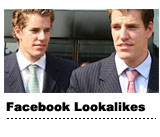 This week Facebook added Lookalike targeting to the pile of low-hanging fruit it has plucked in the data-driven ads space. The offering is closely tied to Custom Audiences, the CRM matching program that allows a brand to find existing customers and prospects by identifying Facebook users through an (anonymized) email address or phone number.
This week Facebook added Lookalike targeting to the pile of low-hanging fruit it has plucked in the data-driven ads space. The offering is closely tied to Custom Audiences, the CRM matching program that allows a brand to find existing customers and prospects by identifying Facebook users through an (anonymized) email address or phone number.
Facebook’s Lookalike option takes Custom Audiences a step further by identifying users with traits in common with existing customers. The point, of course, is expanding audience reach within a narrowly defined customer segment.
The so-called “Lookalike Audiences” product — first reported by InsideFacebook — comes in two flavors, a spokesperson tells AdExchanger. Campaign managers can optimize for “similarity,” creating new impressions with tight accuracy — and presumably better results. The other is simply called simply “Reach,” and that name says it all. The match is hazier and the ROI lower, but you might acquire more customers overall.
“That is a looser match, if you want to optimize for reaching a larger audience, it’s still very accurate but a bit broader,” the rep said.
In its initial rollout, the Lookalike program is more limited than Custom Audiences. For now it’s only available in the U.S., and only via the Power Editor ads management tool and not the Ads API. An Ads API extension is presumably on the roadmap.
All Facebook targeting criteria can be applied, including geo data, likes, and interests. So in theory, an advertiser could look for people resembling its own customers – but only in the Minneapolis-St. Paul region.
Alex Rogers, Neo@Ogilvy’s Social & Programmatic Director, points out many ad networks, demand side platforms, and data management platforms offer their own flavors of Lookalike targeting. He points out, “This isn’t different from Lookalike targeting you would see on an ad network or DSP, but it’s unique because it allows you to leverage this very specific targeting in the Facebook space.”
Rogers continued,
“The limitation is going to be accuracy of the Lookalike modeling. The real proof will be if Facebook will have the data and consumer insights to find enough similar users that are willing to take the desired action. This isn’t any different from the limitations of any Lookalike modeling except for the fact they aren’t leveraging third party data for extra consumer connection points as you could do with other networks/exchanges. Facebook does seem confident in the product and it could be yet another step in the direction of making Facebook advertising more attractive to DR clients.”
While Facebook has not released specific results from early advertisers, it did share two blind case studies. For what it’s worth:
- An unnamed online travel site saw a 70% lower cost-per-acquisition using Custom Audiences with lookalike targeting.
- An unnamed online shopping site saw a 56% lower CPA, and a 94% lower cost per checkout.
For Facebook, the feature is consistent with a series of recent launches intended to boost incremental ad revenue through automated ad serving, bidding, and optimization. Those moves include retargeting through Facebook Exchange, the Custom Audiences product, and a conversion tracking and algorithmic optimization system called Optimized CPM (AdExchanger story). With these rollouts Facebook has replicated in fairly short order several years’ worth of innovation in the display arena on behalf of its own native ad platform. Of course there’s still fruit in the tree. Future opportunities reside in dynamic creative optimization, ad serving capabilities, and the much discussed ad network option.
Taken as a whole, the moves – which only date back to about the middle of last summer — also portray a company with a product development mindset not unlike Google’s: incremental, fast moving, feature-driven, and relentless in its pursuit of advertiser ROI. And no wonder the similarities, given the growing ranks of staffers who have migrated to Menlo Park from Mountain View.












